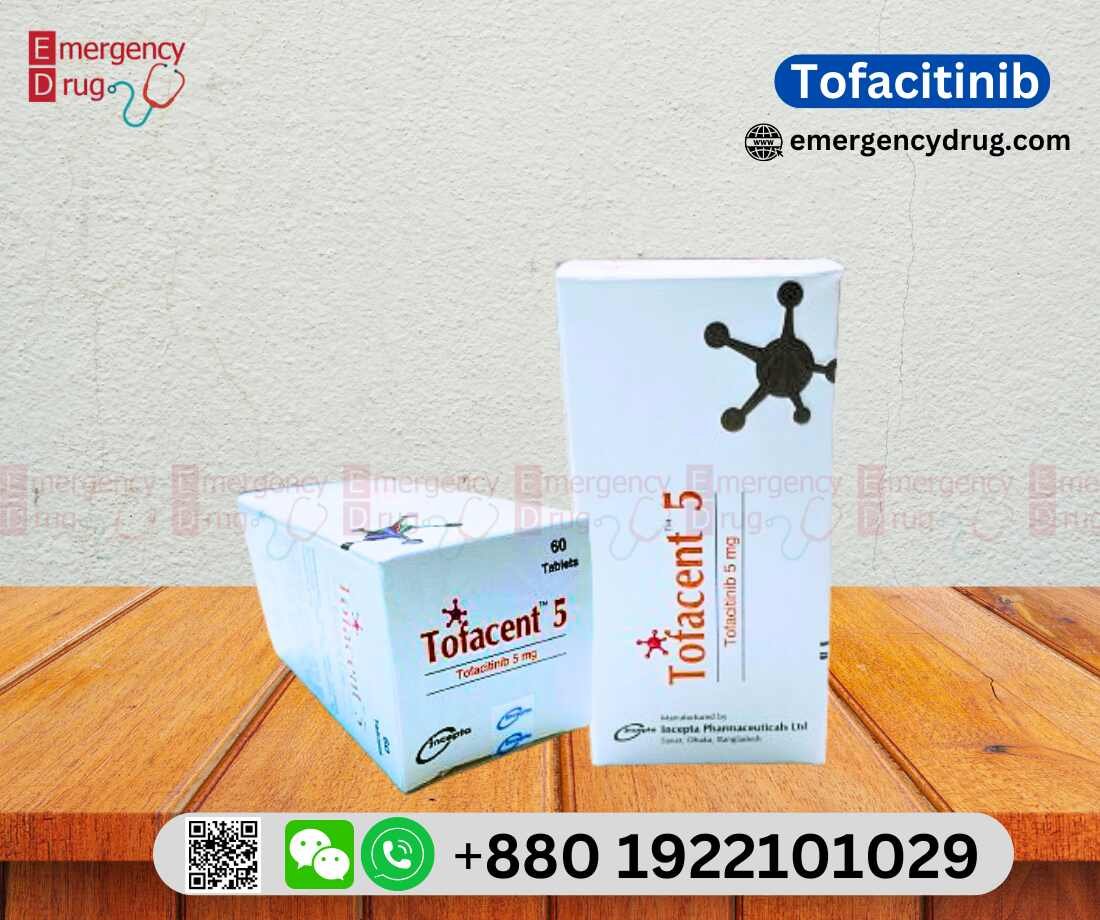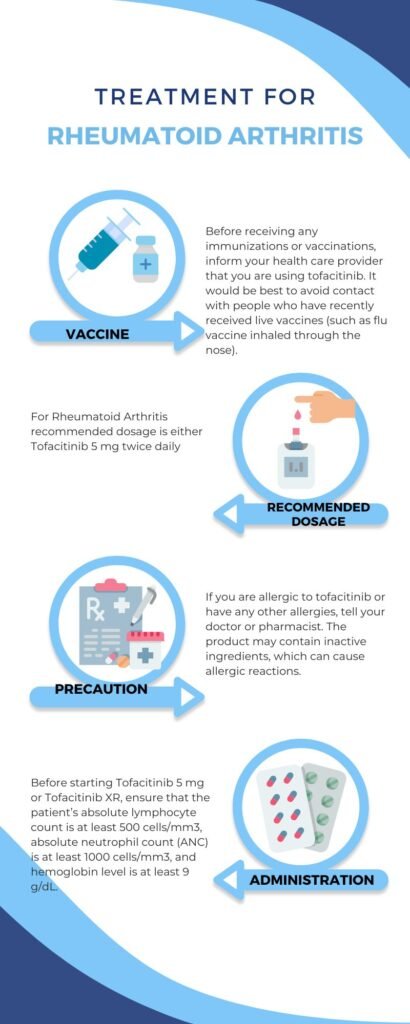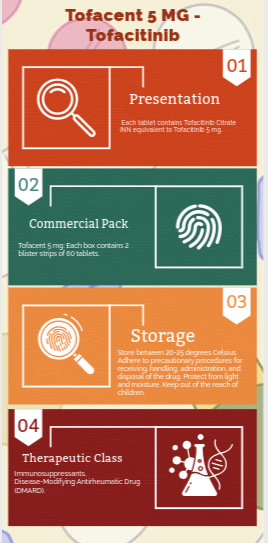Tofacent 5 MG (tofacitinib) – Uses, Side Effects, and More
Mohammad Jewel
17 Mar, 2025

Tofacent 5 MG, containing tofacitinib, is used to treat rheumatoid arthritis and psoriatic arthritis by modulating the immune system to reduce inflammation and slow disease progression, thereby alleviating symptoms like pain, swelling, and stiffness. Common side effects include headache, diarrhea, and upper respiratory tract infections, while serious risks involve severe infections, liver enzyme elevations, and blood clots, necessitating regular monitoring. It is taken orally, typically when other treatments are ineffective, and requires adherence to healthcare provider instructions and prompt reporting of unusual symptoms for safe and effective use.
Table of Contents
Tofacent 5 MG
Tofacent is a tablet used for rheumatoid arthritis and psoriatic arthritis. It is an effective tablet for patients who are able to achieve rapid disease relief. Tofacent 5 MG is a pyrrolopyrimidine that is pyrrolo [2,3-d]pyrimidine substituted at position 4 by an N-methyl, N-(1-cyanoacetyl-4-methylpiperidin-3-yl) amino moiety. Used as a citrate salt to treat active rheumatoid arthritis (moderately to severe).
Manufacturer
Tofacent is produced by Incepta Pharmaceuticals Limited. Incepta Pharmaceuticals is a leading pharmaceutical company based in Bangladesh. Founded in 1999, Incepta has grown to become one of the largest and most prominent pharmaceutical manufacturers in the country, with a strong presence in both the domestic and international markets. There are several alternative brands of Tofacent that are produced in Bangladesh.
Display
Tofacent 5 mg: Per tablet contains Tofacitinib Citrate INN Corresponding to Tofacitinib 5 mg.
Tofacent 10 mg: Per tablet contains Tofacitinib Citrate INN Corresponding to Tofacitinib 10 mg
Tofacent 11 mg: Per tablet contains Tofacitinib Citrate INN Corresponding to Tofacitinib 11 mg.
Retail Pack
Tofacent 5 mg: Per box contains 60 tablets.
Tofacent 10 mg: Per box contains 60 tablets.
Tofacent 11 mg: Per box contains 30 tablets.
Indications of Tofacent
Tofacent was originally developed to prevent solid organ allograft rejection and tested for treating inflammatory bowel disease, spondylarthritis, psoriasis, and dry eyes. Now, doctors prescribe it to adult patients with moderate to severe active Rheumatoid Arthritis (RA) who cannot tolerate Methotrexate, a chemotherapy agent and immune-system suppressant also used in treating rheumatoid arthritis.
RA is a progressive, autoimmune, and inflammatory disease that can shorten life reduces mobility, and affects the quality of life. It dysregulates pro-inflammatory cytokines including IL-7, IL-15, IL-21, IL-6, IFN-alpha, and IFN-beta that stimulates and regulates the recruitment of immune cells via the JAK-STAT signaling pathway. Aside from RA, it is used also for the treatment of other types of arthritis like Psoriatic Arthritis and Polyarticular Course Juvenile Arthritis (PCJIA). It also benefits people with bowel diseases like ulcerative colitis and reduces its accompanying symptoms (diarrhea, stomach pain, and rectal bleeding).
Mechanism of Action
Tofacitinib is a synthetic small molecule that interrupts the JAK-STAT signaling pathway that plays a major role in the pathogenesis of RA. In patients taking this drug, a remarkable decrease in the C-reactive protein can be noted because this drug decreases the inflammatory response. visit our blog page to know How Tofacitinib works to Treat Chronic Diseases.
Pharmacokinetics
Absorption: It is an oral drug, rapidly absorbed in the gastrointestinal tract, with a bioavailability of 74% and an elimination half-life of 3 hours. The peak of plasma concentration is 0.5-1 hour.
Distribution: Equal distribution to the plasma and RBC. Approximately 40% is bounded to albumin. The volume of distribution is 87 L.
Metabolism and Excretion: The CYP3A4 enzyme metabolizes about 70% of the drug in the liver, and the remaining 30% is excreted unchanged by the kidneys. Patients with severe hepatic disease should not take it.

Tofacent 5 MG Tablet Uses
Psoriatic Arthritis
• If with failure with prior DMARD therapy, Tofacitinib can be used as a monotherapy or combination with methotrexate or other non-biological DMARDs. Take the following dosage:
o Immediate Release Tablet: 5 mg twice daily
o Extended-Release Tablet: 11 mg once daily
• If ALC <500 cells/mm3, ANC <1,000 cells/mm3, and Hb <9 g/dL, do not take medication.
Rheumatoid Arthritis
• If with failure with prior DMARD therapy, Tofacitinib can be used as a monotherapy or combination with methotrexate or other non-biological DMARDs. Take the following dosage:
o Immediate Release Tablet: 5 mg twice daily
o Extended-Release Tablet: 11 mg once daily
• If ALC <500 cells/mm3, ANC <1,000 cells/mm3, and Hb <9 g/dL, do not take medication.
Ulcerative Colitis
• Immediate release tablet – 10 mg twice daily for 8 weeks. Maybe extended for 16 weeks if the therapeutic benefit is not yet achieved then discontinue.
• Maintenance—5 mg tablet twice daily, can be titrated to 10 mg twice daily in patients with failed TNF antagonist therapy or patients with no improvement with 5 mg therapy.
• If ALC <500 cells/mm3, ANC <1,000 cells/mm3, and Hb <9 g/dL, do not take medication.
Additional
- For patients taking ketoconazole (a potent CYP3A4 inhibitor) and fluconazole (a potent CYP2C19 inhibitor), reduce the total daily dose of the drug from 5 mg twice daily to 5 mg once daily IR.
- For patients on hemodialysis, take 5 mg IR tablet once daily.
- For patients with hepatic impairment, take 5 mg IR tablet once daily.
- It may take 3 to 6 months to have remarkable therapeutic effects so this medication should be continued for as long as it is prescribed by the attending physician.
- For a missed dose, take it as soon as possible. If it is already nearing the next dose, skip the missed dose and resume to the regular schedule. Never double the dose to catch up, it may cause an overdose.
Tofacent 5 mg Side Effects
Adverse Effects
Tofacitinib slightly increases the risk of infection. The most common infections associated with this drug are upper respiratory tract infection and urinary tract infection. Most serious infections include pneumonia, cellulitis, esophageal candidiasis, and other opportunistic infections.
A more significant adverse reaction is a malignancy (lymphoma, non-melanoma skin cancer), Epstein-Barr virus-associated post-transplant lymphoproliferative disorder, bone marrow suppression, cardiovascular effects, hypersensitivity reactions, and lipid abnormalities.
An increase in low-density lipoprotein (LDL), high-density lipoprotein (HDL), and total cholesterol are dose-dependent and usually remarkable beginning about 6 weeks after initiation of treatment. Because of this, lipid levels should be monitored at least once a month or every three months. Neutropenia, leucopenia, and anemia can occur requiring drug discontinuation.
The other reported side effects
- Gastrointestinal disorders: Nausea, vomiting, abdominal pain, dyspepsia, gastritis.
- General disorders and admin site conditions: Pyrexia, fatigue, peripheral edema.
- Hepatobiliary disorders: Hepatic steatosis.
- Musculoskeletal and connective tissue disorders: Arthralgia, musculoskeletal pain, joint swelling, tendonitis.
- Psychiatric disorders: Insomnia.
- Skin and subcutaneous tissue disorders: Rash, erythema, pruritus.
- Vascular disorders: Hypertension.
Potentially fatal effects are those infections caused by bacterial, fungal, and viral opportunistic pathogens. Also including thrombosis, embolism, DVT, and interstitial lung disease. Careful monitoring of the prescribing physician may decrease the risk of the following adverse effects mentioned. Any side effects experienced should be reported immediately to the healthcare provider especially if one experiences a fast heartbeat for a prolonged time, severe abdominal pain, and persistent nausea and vomiting, and diarrhea for more than a day.
Overdose of Tofacent
An overdose can be accidental or intentional and it happens when the drug was taken more than the medically recommended dose. This can cause immediate death if not treated right away.
Watch out for the signs and symptoms of drug overdose:
- Unstable vital signs—can be low, high, or absent (temperature, pulse rate, respiratory rate, and blood pressure).
- Mental deterioration—sleepiness, confusion, and coma.
- Cool and sweaty, dry or hot skin.
- Chest pain.
- Abdominal pain, nausea, vomiting, and diarrhea.
If someone has overdosed and shows severe signs and symptoms, call a poison center right away.
Miss a dose of Tofacent
- Take the missed dose as soon as you remember, unless it’s almost time for your next scheduled dose.
- If it’s close to the time for your next dose, skip the missed dose and resume your regular dosing schedule. Do not take two doses at the same time to make up for a missed dose.
- Consult your doctor or pharmacist for specific instructions tailored to your treatment plan, especially if you miss multiple doses.
Always follow you doctor’s guidance for the best health.
Use in Special Populations
- For pediatric patients, the safety and effectiveness have not been proven.
- For geriatric patients, should be used with precaution as infections are prevalent among the older people (65 years old and older).
Pregnancy Category (US FDA): C
Animal reproduction studies showed an adverse effect on the fetus and there are no sufficient and well-controlled studies in humans. There are potential benefits for pregnant women upon usage despite potential risks. Tofacitinib should be used only if the benefit outweighs the potential risk to the fetus.
Drug Interactions
- Potent inhibitors of Cytochrome P450 3A4 (CYP3A4) and CYP2C19 (e.g. tacrolimus, ciclosporin, ketoconazole, fluconazole).
- Greater risk for gastrointestinal perforation with corticosteroids and NSAIDs
- Reduced clinical response if currently in rifampicin therapy.
- Potentially fatal as an additive immunosuppressor with biologic DMARDs, immunosuppressants (e.g. tacrolimus, ciclosporin), and live vaccines.
Food Interaction
St. John’s wort may decrease tofacitinib serum concentration.
Contraindications
Patients with active infections such as active and inactive tuberculosis should not receive tofacitinib. Before starting this drug, they may need to be screened for tuberculosis (skin test, chest X-ray). Doctors advise against the use of tofacitinib in patients with sepsis, opportunistic fungal infections, shingles, cancer or malignancy, hypercholesterolemia, neutropenia, leukopenia, thrombosis, embolism, diverticulitis, abnormal liver function tests, lymphoid tissue disorders, and patients after stomach transplantation. , chronic kidney disease stages 3A, 3B, 4, 5, and Child-Pugh class B liver impairment. Also contraindicated to pregnant and breastfeeding mothers, in patients undergoing major surgery, and in patients using hormonal contraceptives.
Special Precautions
Doctors implement vigilant safety measures for patients with a history of opportunistic infections, chronic and recurrent infections, recent exposure to TB patients, diabetes mellitus, bradycardia (heart rate less than 60 beats per minute), arrhythmias, syncope, ischemic heart disease, and heart failure. Also, in patients with high risks of thrombosis or pulmonary embolism, hypertension, and hyperlipidemia. Special precautions are also given to patients who traveled to areas with endemic tuberculosis or mycoses, Asian race, and severe renal disease, and moderate hepatic disease.
Monitoring Parameters
- After 4-8 weeks of taking the drug, monitor neutrophil, lymphocyte, and platelet counts and every 3 months thereafter.
- Monitor lipid profile 4-8 weeks after initiation of treatment and continuously once a month or every 3 months.
- Examine electrocardiogram, heart rate, blood pressure subsequently.
- Periodic skin examination.
- Thoroughly monitor for signs and symptoms of infection such as inflammation, redness, and fever.
- Check abdominal symptoms during and after treatment.
- Watch out also for signs and symptoms of pulmonary embolism before, during, and after treatment.
- Conduct antibody testing for viral hepatitis before therapy and thereafter.
- Screen for latent and active tuberculosis before, during, and after therapy.

Therapeutic Class
Janus Kinase (JAK) Inhibitor / Immunosuppressant.
Disease-Modifying Antirheumatic Drug (DMARD).
Safety Advice: Alcohol, Pregnancy, and More
I. Alcohol: Limit alcohol consumption, as it may increase the risk of liver problems.
II. Pregnancy: Avoid during pregnancy.
III. Breastfeeding: Not recommended.
IV. Driving: Exercise caution if experiencing dizziness or fatigue.
V. Kidney/Liver: Dose adjustments may be necessary. Consult your doctor.
Storage
Store between 20-25 degrees Celsius. Adhere to precautionary procedures for receiving, handling, administration, and disposal of the drug. Protect from direct sunlight and moisture. Keep away from children.
Mode of Action: How Tofacent 5 mg Targets Inflammation
Tofacitinib’s mode of action centers on its ability to inhibit JAK enzymes. This inhibition disrupts the signaling of cytokines, which are proteins that play a crucial role in inflammation.
Uses of Tofacent Tablet: Comprehensive Applications
Beyond the primary indications, Tofacent tablet is used to manage the symptoms of RA, PsA, and UC by reducing inflammation and improving joint function and bowel health.
Benefits of Tofacent Tablet: Improving Quality of Life
Tofacent tablet can significantly improve quality of life by:
- Reducing pain and swelling
- Improving joint mobility
- Reducing bowel inflammation
- Decreasing fatigue
Medications and Exercises: Complementary Approaches
Combining Tofacent 5 mg with appropriate exercises and other medications, as prescribed by your doctor, can enhance treatment outcomes.
Alternative Medicine Brands: Exploring Options
There are other brands that contain Tofacitinib, such as Tocit 5mg, Xeljanz 5mg, Tofacent 5mg, Tofacinix 5mg, Tofacinix 11mg, Tofaxen 5mg, Jakura 5mg. Always consult with your doctor before switching brands.
Use In Special Populations: Tailored Considerations
Older adults and individuals with kidney or liver problems may require dose adjustments.
Conclusion: Empowering Your Health Journey
Tofacent 5 mg can be an effective treatment option for managing chronic inflammatory conditions. Always work closely with your healthcare provider to ensure safe and effective use.
FAQs
Is tofacitinib a painkiller?
Ans: No, Tofacitinib does not work like a direct painkiller. It is used for rheumatoid arthritis, Psoriatic Arthritis, Ulcerative Colitis, Limitations.
Does tofacitinib regrow hair?
Ans: To some extent, it works well to re-grow hair. Doctors suggest this medication for Alopecia Areata.
What are the common side effects of Tofacitinib 5 MG tablet?
Ans: The side effects that are common with the following include headache, uri, nausea, and diarrhea.
Can I take Tofacitinib 5 MG tablet with other medicines?
Ans: Concomitant medications may interact with other drugs, so inform your physician about all the drugs you are taking.
Is Tofacitinib 5 MG tablet safe for long-term use?
Ans: Although Tofacitinib 5 MG tablet is generally well-tolerated, information on the long-term safety of Tofacitinib is still being collected. Consider the potential risks and benefits as well.
Can Tofacent 5 mg cause weight gain?
Ans: While not a common side effect, some individuals may experience weight changes. Monitor your weight and discuss any concerns with your doctor.
Disclaimer: This information is provided solely for educational reasons and should not be considered medical advice. Always consult with your doctor or healthcare professional before taking any drug.
Visit for more related Medicine
